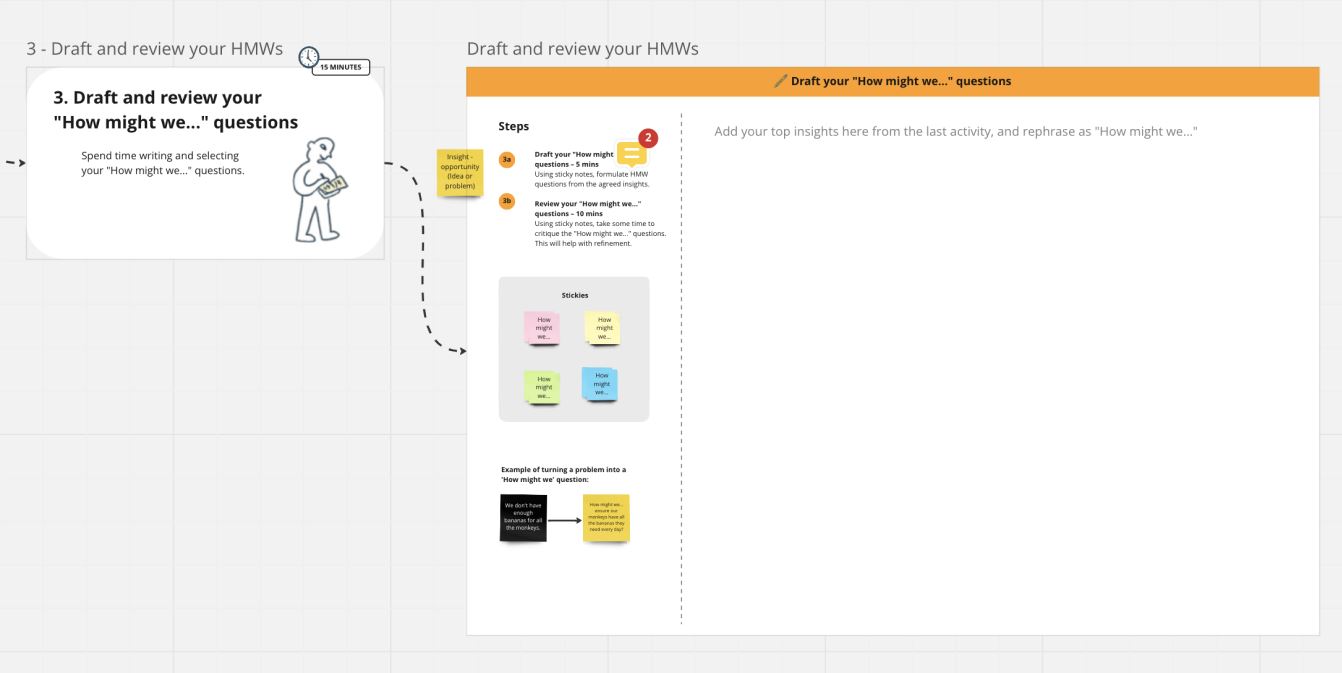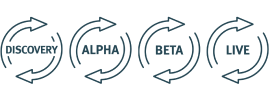How might we
Every solution should come from a question: "how might we...?". Once you have gained insights, how might we (HMW) questions help to frame the ideas you come up with. Instead of focusing on the problem and jumping straight to solutions, we can reframe the challenge on the right problems.

Outcomes
- Reframe problems into questions
- Create questions that provoke meaningful and relevant ideas
- Frame the design challenge
What you need
| Remote | In-person |
|---|---|
|
|
Instructions
Most plays in this playbook involve minimal preparation. With the how might we play, there is a small amount of preparation required to help your participants understand the goal and get the most out of the session.
Preparation time will depend on the depth of insights (e.g. are these from user testing and require collation or is this internal data).
Invite your participants
Participants in this session should be made up of the project team and any subject matter experts relevant to the project. This might include a Project Manager (PM), Project Officer, Designer, Business Analyst, Communications Officer, Solution Architect, or Developer. Aim for including a range of people to form a multi-disciplinary team. You’ll want to make sure when you send an invite for the session, that you clearly explain the goal, how long it’ll take, and why people’s participation will be beneficial.
It’s important to give enough notice to ensure participants have free time to come along to the session. Aim to send invitations about 2 weeks in advance.
You can also attach the play for people to look at ahead of time.
Here’s a calendar invitation template you can use when inviting participants:
Calendar invite for how might we
Subject:
How might we workshop for [project name]
Meeting description:
Hi [team name if sending a group invitation, or participant name if sending individual invitations]
As part of our [name of project] work, we're at the stage where we need to diverge our thinking and frame our ideas before we move into the next stage of the project. In this session we will be reviewing current insights and coming up with "how might we..." questions to inspire ideas. A "how might we..." is a question used help to frame ideas.
The session will take about [x] minutes and there is no preparation required.
Having [you/each of you] attend will help to create diversity of questions and broader solutions for our project. It will also help us to align on our direction for development. We will be using Miro for this workshop, and you can read more about the how might we session in the Digital service design playbook.
Let me know if you are interested in participating [if you’re planning to record the session make sure to ask for participant consent here].
Kind regards,
[Facilitator name]
Collate the insights
For this play, it will be beneficial to have a summarised list of insights in Miro, or in an embedded document to help remind the team of what to focus on during the session. Whether these are internal insights (such as data from the customer contact centre, staff feedback, or other work from your project) or external insights (such as user testing feedback) there should be a space that your team can view and discuss these in Miro.
Either do this by adding sticky notes which summarise your insights, or you can embed a document (PDF) into the Miro board for participants to review at the start of the session.
Insights can include:
- User/customer feedback
- Interview verbatims
- Problems and pain points (customer, user, or organisation)
- Ideas
1. Introduction – 10 mins
If using Miro, check that everyone knows how to navigate and use the board.
Welcome the team and start by explaining what each section of the template is all about. Give an introduction to the components of "how might we..." questions.
"How" suggests that we do not yet have the answer. “How” helps us set aside prescriptive briefs. “How” helps us explore a variety of possibilities instead of focusing on what we “think” the solution should be.
"Might" emphasises that our responses are possible solutions, not the only solution. “Might” also allows for the exploration of multiple possible solutions, not settling for the first that comes to mind.
"We" immediately brings in the element of a collaborative effort. “We” suggests that the idea for the solution lies in our collective teamwork.
2. Review and narrow down insights – 15 mins total
As a group, decide on what the top insights are by reviewing and narrowing them down.
2a. Review the insights – 10 mins
Start discussing the insights on hand. If the team doesn’t know where these are from – explain the context. These could be internal insights such as the call centre, or it could be more in-depth insights uncovered during user testing.
2b. Narrow down insights – 5 mins
Spend some time agreeing on what the top findings were. Complete a quick dot voting session where everyone gets three votes each. The top insights will become the foundation of your "how might we..." questions.
3. Draft and review your "how might we..." questions – 15 mins total
Spend time writing and selecting your "how might we..." questions.
3a. Draft your "how might we..." questions – 5 mins
Now is the chance to spend time writing and selecting your "how might we..." questions before you begin ideating. Use 5 minutes to get everyone in the session to individually write a "how might we..." question from the agreed insights.
Tip:
Try reframing the problem as a question.
Problem: Customers are contacting us too frequently needing help through too many challenges in the service.
Question: How might we help customers efficiently self-serve through the website?
Problem:Users often call us because they’re unsure about the application process.
How might we (poor):How might we stop users from calling us?
How might we (good):How might we make users feel confident they have all the information they need?
3b. Review your "how might we..." questions – 10 mins
Share your draft "how might we..." questions as a group and review them based on the following:
- Does it suggest a solution? If so, try to think more broadly and avoid focusing on a particular solution
- Is it too specific? Could this be written in a broader way? The broader the "how might we..." question, the more ideas can be generated.
- Does it focus on the desired outcome? It's important to frame the question around the root problem rather than the symptoms of the problem.
- Is it phrased negatively? Try to frame the question positively to encourage creativity and idea generation.
4. Refine your "how might we..." questions – 20 mins
Use the remaining workshop time to refine your "how might we..." questions as a team. While there is no limit on how many "how might we..." questions you should produce, you might find a simpler problem will lead to fewer "how might we..." questions (around 10), whereas, if you have a complex problem, this will naturally lead you to create more 'how might we..." questions to respond to different problems and insights (10+).
We can think about a project affecting one service or product, vs another that might span multiple touchpoints.
Tip
"How might we…", generation encourages more of a creative, explorative mindset and is less focussed on the restrictions and more focused on boundaries.
If you start to notice overlap between "how might we..." questions, see if you can combine some into one broader "how might we...". This is a good way to create alignment.
Do this by grouping similar "how might we..." questions and themes together in Miro, then attempting to rewrite them.
Go through the following checklist to help select or improve the "how might we..." questions:
- Is it based on an existing problem or insight? Good
- Does it track a desired outcome? Good
- Is it written positively? Good
- Is it broad enough to ensure many creative ideas? Good
- Does it suggest a solution? Bad
5. Wrap up – 5 mins
Thank everyone for their time. Let them know what to expect next, and if there are any follow-up activities.
If using this process as part of a larger workshop, move on to the next activity.
Once you've completed the session, spend 30 minutes going over the play outcomes. You can do this individually as a facilitator, or if you’d prefer, you can run a team debrief. Spend this time tidying up the board to help with reviewing outcomes later.
Now that you have a list of "how might we..." questions, your team can use these as a way to generate ideas. Plays to help with idea generation include silent brainstorming and powers of ten.
You can also prioritise your "how might we..." questions in terms of their impact on the project’s success. More plays to help with prioritisation are coming soon.
Resources
See below for a collection of templates and other pages which will help you run this play. These resources are also linked in the play instructions.
Subject:
How might we workshop for [project name]
Meeting description:
Hi [team name if sending a group invitation, or participant name if sending individual invitations]
As part of our [name of project] work, we're at the stage where we need to diverge our thinking and frame our ideas before we move into the next stage of the project. In this session, we will be reviewing current insights and coming up with "how might we..." questions to inspire ideas. A "how might we..." is a question used help to frame ideas.
The session will take about [x] minutes and there is no preparation required.
Having [you/each of you] attend will help to create a diversity of questions and broader solutions for our project. It will also help us to align on our direction for development. We will be using Miro for this workshop, and you can read more about the "how might we" session in the Digital service design playbook.
Let me know if you are interested in participating [if you’re planning to record the session make sure to ask for participant consent here].
Kind Regards,
[Facilitator name]
